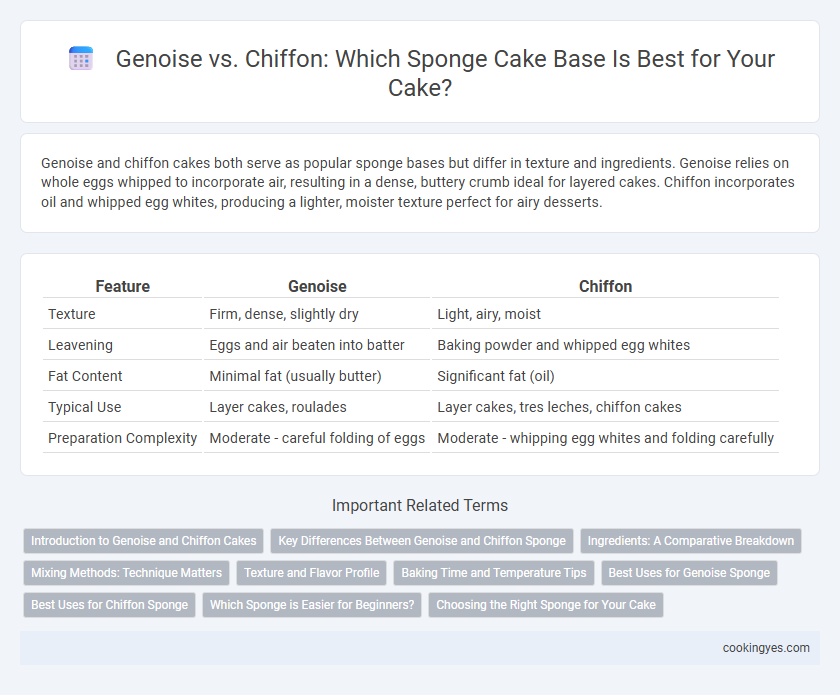Genoise and chiffon cakes both serve as popular sponge bases but differ in texture and ingredients. Genoise relies on whole eggs whipped to incorporate air, resulting in a dense, buttery crumb ideal for layered cakes. Chiffon incorporates oil and whipped egg whites, producing a lighter, moister texture perfect for airy desserts.
Table of Comparison
| Feature | Genoise | Chiffon |
|---|---|---|
| Texture | Firm, dense, slightly dry | Light, airy, moist |
| Leavening | Eggs and air beaten into batter | Baking powder and whipped egg whites |
| Fat Content | Minimal fat (usually butter) | Significant fat (oil) |
| Typical Use | Layer cakes, roulades | Layer cakes, tres leches, chiffon cakes |
| Preparation Complexity | Moderate - careful folding of eggs | Moderate - whipping egg whites and folding carefully |
Introduction to Genoise and Chiffon Cakes
Genoise cake is an Italian sponge made with whole eggs, sugar, and flour, relying on the air incorporated during beating for its light texture without using baking powder. Chiffon cake combines the richness of a butter cake with the lightness of a sponge, using vegetable oil, baking powder, and whipped egg whites to achieve its moist and airy base. Both cakes serve as versatile foundations for layered desserts, with Genoise offering a drier crumb suited for soaking and Chiffon providing a tender, fluffy alternative.
Key Differences Between Genoise and Chiffon Sponge
Genoise sponge is made using whole eggs whipped with sugar and folded with flour, resulting in a dense, firm texture ideal for layered cakes and pastries. Chiffon sponge incorporates oil, baking powder, and whipped egg whites, creating a lighter, moister cake with a tender crumb, perfect for airy desserts. The key differences lie in ingredient composition and texture, with Genoise offering structure and Chiffon delivering softness and moisture.
Ingredients: A Comparative Breakdown
Genoise sponge primarily relies on whole eggs and sugar gently heated together to create a dense, sturdy base with no chemical leaveners, while chiffon cake combines whipped egg whites, vegetable oil, sugar, and baking powder for a lighter, moister texture. The absence of oil in genoise results in a firmer crumb, ideal for layered cakes that need structural integrity, whereas chiffon's inclusion of oil and baking powder produces a more tender and airy crumb suitable for delicate desserts. Both sponges utilize flour, but chiffon requires cake flour for optimal softness, whereas genoise can use all-purpose flour due to its thicker batter consistency.
Mixing Methods: Technique Matters
Genoise relies on an egg-foam method where whole eggs are gently whipped with sugar over heat to create a stable foam without chemical leaveners, resulting in a dense, tender sponge. Chiffon cake combines the chiffon technique by folding whipped egg whites into a batter leavened by baking powder, producing a lighter, airier texture with greater volume. Mastery in folding and mixing methods critically impacts the final crumb structure and moisture, with genoise requiring careful, gradual incorporation to maintain structure and chiffon demanding delicate handling to preserve the egg white aeration.
Texture and Flavor Profile
Genoise cake features a dense, firm texture created by carefully folding warmed eggs and sugar, resulting in a rich, buttery flavor profile with subtle caramel notes. Chiffon cake offers a light, airy crumb due to the incorporation of whipped egg whites and oil, delivering a moist, tender bite with a delicate, slightly sweet taste. Texture differences stem from the fat content and mixing techniques, while flavor nuances depend on ingredients like butter in genoise versus oil in chiffon.
Baking Time and Temperature Tips
Genoise cake requires baking at a moderate temperature of around 325degF (163degC) for 25 to 30 minutes to ensure even rising and a firm texture without drying out. Chiffon cake bakes best at a slightly higher temperature of 350degF (177degC) for 30 to 35 minutes, allowing the light and airy structure to set while maintaining moisture. Monitoring oven temperature and avoiding overbaking are crucial for both to achieve the ideal sponge base with optimal softness and crumb.
Best Uses for Genoise Sponge
Genoise sponge is best suited for layered or rolled cakes that require a firm yet tender crumb to hold fillings and frostings without collapsing. Its dry, airy texture absorbs syrups and liqueurs beautifully, making it ideal for intricate desserts like opera cake and tiramisu. Unlike chiffon, Genoise relies on whipped whole eggs instead of oil, providing a sturdy base that supports delicate decorations and multiple layers.
Best Uses for Chiffon Sponge
Chiffon sponge excels as a light, airy cake base ideal for layered cakes filled with whipped cream or fruit, providing moisture and tenderness unmatched by denser genoise. Its high oil content and baking powder leavening create a delicate, flexible texture perfect for intricate decorations and rolled cakes. Chiffon sponge's versatility makes it the preferred choice for wedding cakes, chiffon roll cakes, and tropical fruit-filled desserts.
Which Sponge is Easier for Beginners?
Genoise offers a simple sponge base that relies on whole eggs whipped with sugar, making it easier for beginners due to minimal ingredients and straightforward technique. Chiffon cake, while lighter and more airy, requires careful folding of whipped egg whites and oil incorporation, which can be challenging for novice bakers. Therefore, Genoise is generally more beginner-friendly for those learning to bake sponge cakes.
Choosing the Right Sponge for Your Cake
Genoise and chiffon cakes differ significantly in texture and ingredients, making them suitable for different cake bases. Genoise relies on whole eggs beaten to incorporate air without chemical leaveners, resulting in a dense, firm crumb ideal for layered or rolled cakes. Chiffon uses baking powder and oil, producing a light, moist sponge perfect for airy, tall cakes that require more moisture and softness.
Genoise vs Chiffon for sponge base Infographic

 cookingyes.com
cookingyes.com